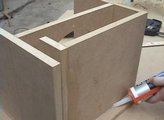Subwoofer Enclosure Design
Today I finally finished putting up the subwoofer enclosure plans I had started about three months ago. The purpose of these plans is to illustrate the effects that different enclosures have on the same woofer. In this case, the JL Audio 10W1.
Sealed Enclosure
The first enclosure is a simple sealed enclosure. Using the computer modeling program WinISD we're given an ideal enclosure size of 1.55 cubic feet. With this design we'll have a gentle rolloff in response with the half power frequency (3 dB downpoint) at 42 Hz. This is a basic design and we'll get a lot of smooth bass from this enclosure. However, if we wanted to improve the low bass output we might look at the next design.
Vented Enclosure
The vented (or ported) design recommendation is for a 3.2 cubic foot enclosure tuned to 24 Hz. This is achieved using a four inch diameter port that is about fifteen inches long. Taking the size of the port into account we actually need a 3.3 cubic foot box. This is a VERY large enclosure for a single ten inch woofer but in return we get a lot more low bass. The half power frequency is now 24 Hz, a full octave increase over the sealed design. And at 30 Hz the vented enclosure delivers seven more decibels of output. The equivalent of more than quadrupling the amplifier power (at those frequencies).
Bandpass Enclosure
The final design is the single-reflex bandpass enclosure. WinISD recommends a 2.5 cubic foot box tuned to 42 Hz. This alignment gives nearly identical low frequency response but the high frequency 3 dB downpoint is now 70 Hz. In my opinion this is too much cutoff for those frequencies. The typical subwoofer range should extend to at least 90 Hz. But if you're looking to increase your low bass response only (rap for example) then this may be a good choice. You'll be getting the frequencies you want and can leave the upper bass to a good pair of front speakers.
Conclusion
Every enclosure has it's advantages and disadvantages. This is why it's so important that you know what kind of sound you're designing for. A classical music fan is not going to appreciate the bandpass enclosure above and an SPL junkie is not going to want the sealed enclosure that was recommended. By using computer modeling software we can get fairly predictable results without having to actually build the enclosure. Then we can adjust the enclosure size, tuning frequency and driver used to get just what we're looking for.

You should also check out Advanced Enclosure Design and Fabrication. It covers designing enclosures using free computer software, maximizing the output of a subwoofer system, building the box like a pro and testing the output using inexpensive equipment. Click here.
Back to the Newsletter Archives Index